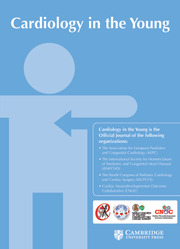No CrossRef data available.
Article contents
Comparison of epicardial fat thickness in macrosomic and non-macrosomic infants of mothers with diabetes
Published online by Cambridge University Press: 10 April 2025
Abstract
Epicardial fat thickness also increases in insulin resistance and diabetes mellitus patients. In our study, we aimed to compare the epicardial fat thickness and interventricular septum diameter in infants of mothers with diabetes with infants of mothers without diabetes. Also, to determine the effect of birth weight on the epicardial fat thickness and the interventricular septum diameter in infants of mothers with diabetes.
Between November 2022 and June 2023, infants of mothers with diabetes and healthy infants were compared. According to birth weight, infants of mothers with diabetes were divided into two groups, macrosomic infants (≥ 4000 g) and non-macrosomic infants (2500–4000 g).
A total of 78 infants of mothers with diabetes and 56 infants of mothers without diabetes were evaluated. Epicardial fat thickness and interventricular septum diameter were found to be statistically significantly higher in infants of mothers with diabetes than in healthy infants. Epicardial fat thickness and interventricular septum diameter measurements were found to be statistically significantly higher in the macrosomic of infants than in the non-macrosomic of infants of mothers with diabetes. Asymmetric septal hypertrophy was found to be more common in macrosomic infants of diabetic mothers than in non-macrosomic infants, although not statistically significant. We also found a positive correlation between epicardial fat thickness and asymmetric septal hypertrophy.
Epicardial fat thickness is observed to increase along with neonatal macrosomia and heart mass in gestational diabetes mellitus. The lack of a significant increase in epicardial fat thickness and interventricular septum diameter in non-macrosomic infants of mothers with diabetes may be indicative of good glycaemic control in non-macrosomic infants of mothers with diabetes. Therefore, good glycaemic control during pregnancy and long-term follow-up of infants of mothers with diabetes after birth is important.
- Type
- Original Article
- Information
- Copyright
- © The Author(s), 2025. Published by Cambridge University Press



